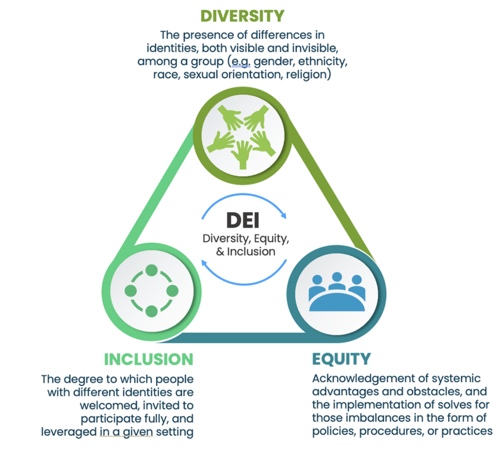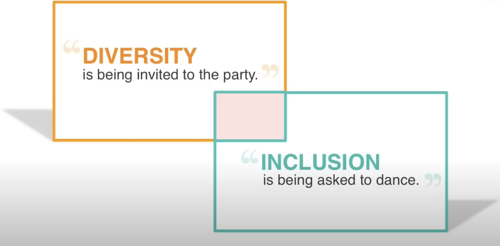Global Ophthalmology, Cataract, Refractive, Society News, Young Ophthalmologists, Inside ESCRS
Thinking Beyond Optics: Diversity, Equity, and Inclusion (DEI) and Unconscious Bias in Ophthalmology

Shady Atamniy
Published: Monday, November 3, 2025
Indeed, diversity, equity, and inclusion (DEI) concepts have gained momentum across various fields. However, in the medical field, particularly in ophthalmology, they remain sporadically applied, poorly understood, and often seen as peripheral to clinical brilliance. Although well-intentioned, DEI programmes evoke varying responses within the medical community. Nonetheless, beneath the surface of this debate, a fundamental truth remains: unconscious bias and inequality continue to influence ophthalmology training, practice, and research, often to the disadvantage of clinicians and patients.
Diversity, equity, and inclusion in ophthalmology today
Traditionally, ophthalmology has been regarded as an exceptionally exclusive and competitive speciality. Securing a place in training remains heavily biased, with many individuals from lower socioeconomic backgrounds, underrepresented ethnic minorities, or without academic or family ties in medicine facing significant obstacles. When investigated, gender disparities among mentorship programmes in ophthalmology have shown that female trainees, compared to their male counterparts, reported significantly lower satisfaction. Furthermore, lower income, decreased rates of goal achievement, and less support in achieving these goals were among the concerns raised.1
Unconscious bias continues to affect recruitment decisions, assessments, interactions with patients, and even who gets access to prestigious cases. Research indicates that in surgical specialities, women experience less autonomy in surgeries compared to their male counterparts, even though their levels of expertise are similar.2 Similar disparities are also seen in academic authorship and research funding allocations. Racial and ethnic minorities are underrepresented as lead or senior authors in ophthalmology journals.3
The importance of addressing DEI
Adopting a DEI approach is not just a moral duty for ophthalmologists. It’s crucial for the long-term sustainability and quality of the field. Research has consistently shown that diverse teams make better clinical decisions, drive more innovative research, and achieve higher patient satisfaction.4 Figure 1 underscores how diversity, equity, and inclusion comprise a comprehensive institutional culture approach. Making trainees feel valued, supported, and mentored increases the likelihood of staying in the field, flourishing, and making a meaningful contribution. DEI promotes a sense of belonging, which helps reduce burnout—a growing problem in ophthalmology—and improves mental well-being.

Equity in care should not be a luxury for patients; it should be a given. Tackling unconscious bias can result in increased trust, earlier diagnoses, and improved treatment adherence. Additionally, involving more diverse patients in clinical trials ensures that healthcare innovations are safe and effective for all populations.6 Figure 2 illustrates a powerful analogy by Verna Myers, an author and lawyer, that underscores the importance of DEI.

From talk to action: What must change?
While raising awareness is crucial, the real priority should be taking concrete, measurable steps to drive meaningful change.
1. Transparency in recruitment and promotion
Implement a blind review process that can highlight the true qualities of training applicants in hiring and promotion decisions. This should be supported by accurate diversity data reporting and equity audits conducted by institutions to ensure oversight of the process.
2. Programmes for mentorship and sponsorship
Engage senior ophthalmologists with expertise in identifying and addressing unconscious bias to set up targeted mentorship for minority groups. Additionally, sponsorship programmes should be created to motivate mentors to champion their trainees.
3. Research practices with a focus on inclusivity
Develop practical routes for publishing and co-authoring with clinicians from underrepresented minority backgrounds. Meanwhile, promote the use of DEI metrics in research designs for clinical trials to recruit diverse participants.
4. Compulsory DEI and bias training
Incorporating DEI education into curricula leads to meaningful, long-lasting change. This is necessary to tackle the deeply ingrained unconscious bias in our field. Regular assessment intervals are crucial for consistency and should involve clinical mentors and educators.
5. Environmental and policy reform
Institutional involvement is pivotal in facilitating flexible work arrangements, supporting caregivers, and employing proactive strategies to dismantle exclusive networks that restrict opportunities for minority groups. Invest in physical and cultural initiatives that promote inclusivity and implement anonymised and accessible feedback mechanisms.
Biases and inequities in ophthalmology can be mitigated through DEI. This concept should not be dismissed as merely a quota that institutions must fulfil. Its implementation should stem from our collective desire as medical professionals to provide our patients with the best care. It goes beyond fostering a more diverse field and has clinical, educational, and ethical implications. Let us remove the barriers that prevent talent and compassion from reaching their full potential. It is high time we stop simply ‘talking the talk’ and begin ‘walking the walk’ with commitment, courage, and transparency.
Each year, young ophthalmologists are invited to participate in the John Henahan Writing Prize, responding to an essay prompt provided by the medical editors of EuroTimes. This year’s winner is Shady Atamniy MD, an ophthalmologist in training at Eye Clinic, Augenspezialist Wien, Vienna.
Applicants responded to the following prompt:
Diversity, equity, and inclusion (DEI) programmes, however well-intentioned, stir a variety of responses in the corporate and political worlds and in the scientific and medical spheres. What DEI and unconscious bias issues are present in the current culture of ophthalmology training, practice, and clinical research? What are the potential benefits of addressing these issues for patients and ophthalmologists? What kind of meaningful changes need to happen to move beyond ‘talking the talk’ to ‘walking the walk’?
1. Cote SL, Nguyen A, Berry JL, Reid M, Chang J, Chen J, et al. J Womens Health (Larchmt), 2024 Aug; 33(8): 1120–1127.
2. Bond EC, Whiting FH, Larsen PD, Chan G. N Z Med J, 2023 Jul 21; 136(1579): 36–48.
3. Chander S, Luhana S, Sadarat F, Leys L, Parkash O, Kumari R. Annals of Intensive Care [Internet]. 2023 [cited 2025 Jun 8];13(1). Available from: https://link.springer.com/ epdf/10.1186/s13613-023-01157-2
4. Davuluri K, Goyal N, Gomez Acevedo H, Folt J, Jayaprakash N, Slezak M, et al. J Am Coll Emerg Physicians Open, 2022 Sep 17; 3(5): e12798.
5. Snopko A. Vynamic LLC [Internet]. 2025 [cited 2025 Jun 8]. Available from: https://vynamic.com/insights/integrating-diversity-equity-inclusion-throughout-clinical-trials/
6. Serchen J, Doherty R, Hewett-Abbott G, Atiq O, Hilden D. “Understanding and Addressing Disparities and Discrimination in Education and in the Physician Workforce.”
7. Myers V. Diversity & Inclusion [Internet]. 2015 [cited 2025 Jun 8]. Available from: https://www.bu.edu/diversity/ resource-toolkit/diversity-is-being-invited-to-the-party-inclusion-is-being-asked-to-dance/